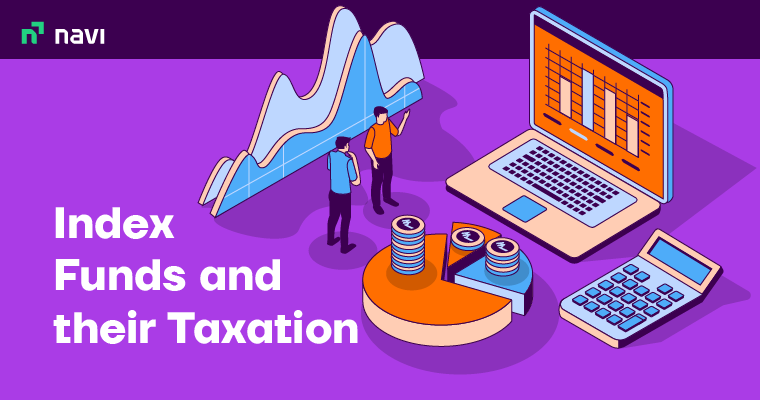Index Funds – Meaning, Types, Advantages and Disadvantages in 2023

What is an Index Fund?
An index fund is a type of mutual fund that invests in a particular stock market index, such as the Nifty 50 or the BSE Sensex. The primary goal of an index fund is to match the performance of the index that it tracks, rather than trying to outperform the market. This means that the fund manager will invest in the same stocks as the index in the same proportion, and the fund’s returns will closely mirror the performance of the index.
Index funds in India are passively managed, which means that the fund manager does not try to actively select individual stocks or time the market. Instead, the manager simply buys and holds all of the stocks in the index in the same proportion as the index.
Origin of the Index Fund
The index fund was first created by John C. Bogle (father of index fund), the founder of Vanguard Group, in 1975. Bogle saw that most actively managed mutual funds were not able to consistently outperform the overall stock market, and he believed that the best way for individual investors to achieve long-term investment success was to simply invest in a low-cost fund that tracked the performance of the stock market as a whole.
Bogle’s idea was to create a fund that held all of the stocks in a particular stock market index, such as the S&P 500. By holding all of the stocks in the index, the fund would provide investors with the same returns as the overall market, minus a small fee for managing the fund. Bogle’s idea was revolutionary at the time because most investors and fund managers believed that the only way to beat the market was to select individual stocks or engage in active management.
Bogle’s index fund, the First Index Investment Trust (later renamed the Vanguard 500 Index Fund), was initially met with skepticism from investors and the financial industry. However, over time, the success of the index fund proved Bogle’s theory correct. Index funds have since become increasingly popular among investors due to their low fees, broad market exposure, and ability to consistently match the returns of the overall stock market.
Today, index funds are widely available from a variety of financial institutions and investment companies, and they are a popular choice for individual investors and institutional investors alike.
Also Read
How Does an Index Fund Work?
Here’s how an index fund typically works:
1. Fund Creation
The fund sponsor creates an index fund by pooling money from individual investors. The sponsor then uses this money to buy stocks or other securities that are included in the index the fund is tracking.
2. Index Tracking:
The fund’s holdings are structured to match the weightings and proportions of the securities in the index, ensuring that the fund’s performance closely tracks the performance of the index.
3. Low-cost Structure:
Index funds typically have low fees and expenses compared to actively managed funds because they do not require as much active management.
4. Diversification:
By investing in a broad market index, the fund provides diversification benefits to investors, as they are exposed to a wide range of companies and industries.
5. Passive Management:
Index funds do not require active management, which means that the fund sponsor does not have to make decisions about which stocks to buy or sell. Instead, the fund manager simply buys and holds the securities in the index.
6. Rebalancing:
Over time, the composition of the index may change due to changes in market capitalization, mergers and acquisitions, or other factors. To ensure that the fund continues to track the index accurately, the fund sponsor periodically rebalances the fund’s holdings to match the index’s current composition.
Overall, index funds are a simple, low-cost way for individual investors to gain exposure to the stock market and achieve broad diversification.
Types of Index Funds in India
In India, there are several types of index funds available for investors to choose from. Here’s a breakdown of the different types, strategies, and risks associated with index funds.
1. Market Capitalisation Index Funds
These funds invest in stock holdings completely in line with their market capitalisation weightages in the underlying index. The holdings with a higher market capitalisation will receive a higher allocation in the index, something that will be closely monitored by the fund manager.
2. Broad Market Index Funds
These funds invest in a large group of investible stocks, often across market capitalisation categories and geographies. An example of this could be an index fund tracking the Nifty 500 or the CRSP US Total Stock Market Index.
3. Factor-based or Smart Beta Index Funds
Recently, factor-based or smart beta funds have got a lot of traction. For example, Edelweiss Nifty 100 Quality 30 Index Fund picks stocks from indices, such as Nifty 100 Quality 30. The stocks are picked on the basis of their quality as based on a score achieved upon analysing the last five years’ return on equity (ROE), financial leverage (debt/equity ratio), and earnings (EPS) growth variability. Factors, such as profitability, stable earnings, and lower leverage are taken into consideration while picking these stocks.
4. Equal Weight Index Funds
These funds invest the same amount of money in every stock in the portfolio mix. In other words, each stock is allocated the same weightage. For example, in the case of a fund tracking NIFTY 50, all the 50 stocks in the fund will be assigned equal weightage.
5. Sector-based Index Funds
These funds invest in shares of companies belonging to the same industry or sector. Many sector-specific funds are available for popular sectors, such as banking, technology, consumption, and healthcare industries.
We recommend investors to invest in a sector-based fund only if they have sufficient knowledge and understanding about the underlying sector the fund tracks.
6. Debt Index Funds
These are passively managed funds that closely track an underlying debt index. Like equity index funds, these are transparent, low-cost, and simple.
7. Custom Index Funds
These are the DIY (Do-It-Yourself) funds. Why? Because unlike standard funds, they don’t fall into the ‘one-size-fits-all’ mould. Yes, the fund manager will still decide when and how to rebalance your portfolio.
But, they will take into consideration not just market risks and opportunities, but also your personal preferences, financial goals, risk tolerance, tax saving goals, and even your values. It is perfect for those investors, who want to implement their own investing strategies under a passive framework, while enjoying the benefits of portfolio diversification, low-cost investing, and risk-adjusted returns.
8. International Index Funds
International funds are mostly Fund of Funds that track international indices. These funds give Indian investors an opportunity to capture the growth in the US market. For example, Navi US Total Stock Market Fund of Fund invests in the Vanguard Total Stock Market ETF (VTI). VTI tracks the performance of the CRSP US Total Market Index which has 4000+ constituents, across small, mid and large cap companies, representing nearly 100% of the US investable equity market.
Also Read
What are the Costs Associated With Index Funds?
Index funds in India generally have lower costs compared to actively managed mutual funds, but there are still some costs associated with investing in these funds. Here are the main costs that investors should be aware of when considering an index fund:
1. Expense Ratio
This is the annual fee charged by the fund house for managing the fund. It includes various expenses such as management fees, administrative costs, and other operating expenses. Index funds in India typically have lower expense ratios compared to actively managed funds because they do not require as much research and analysis.
2. Tracking Error
While index funds are designed to track the performance of a particular index, there may be some variation in the fund’s returns compared to the index due to factors such as transaction costs and fund expenses. This difference is called tracking error, and it is typically measured as a percentage of the fund’s returns compared to the index.
3. Exit Load
This is a fee charged by the fund house when an investor redeems or sells their units before a certain period. The exit load can vary between different funds, and it is typically a percentage of the redemption amount.
4. Taxes
Index funds in India are subject to capital gains tax and dividend distribution tax, which are discussed in more detail in another question.
Investors should compare the costs of different index funds before making an investment decision. While fees may seem small, they can have a significant impact on overall returns over the long term. It’s also important to keep in mind that past performance is not a guarantee of future returns, and investors should carefully consider their investment goals and risk tolerance before investing in any fund.
Who Should Invest in an Index Fund?
Index funds can be a good investment option for a wide range of investors, depending on their investment goals and risk tolerance. Here are a few types of investors who might benefit from investing in an index fund:
1. Beginners
Index funds are a great option for new investors who are just starting to build their portfolio. Because they offer instant diversification across a large number of stocks, index funds can help beginners to reduce their risk exposure and gain exposure to the stock market.
2. Passive Investors
Index funds are ideal for investors who prefer a “set it and forget it” approach to investing. Since index funds are passively managed and track the performance of a particular market index, they require very little maintenance or attention from the investor.
3. Long-term Investors
Index funds are a good option for investors with a long-term investment horizon. Over the long run, index funds have historically provided strong returns that have kept pace with the overall stock market.
4. Cost-conscious Investors
Index funds typically have lower fees compared to actively managed funds, which can save investors money over the long run.
5. Investors Who Want to Avoid Market Timing
Index funds can be a good choice for investors who want to avoid the risks associated with trying to time the market. By investing in an index fund, investors are essentially betting on the long-term performance of the overall market rather than trying to predict short-term market movements.
It’s worth noting that index funds may not be the best investment option for every investor. For example, investors with a high tolerance for risk or those who are seeking out individual stocks for their growth potential may prefer other investment strategies. Ultimately, the best investment strategy will depend on an individual’s unique financial situation and investment goals.
How to Invest in Index Funds in India?
Investing in index funds in India is a simple process and can be done in the following steps:
1. Open a Demat Account
In India, you need a Demat account to invest in index funds. A Demat account holds your investment in electronic form, and you can open it with a registered depository participant (DP) or a broker.
2. Choose the Index Fund
Select the index fund you want to invest in. There are various index funds available in India that track different indices like Nifty 50, BSE Sensex, Nifty Midcap, and others.
3. Choose the Investment Method
There are two ways to invest in index funds in India – lump sum or Systematic Investment Plan (SIP). If you have a lump sum amount to invest, you can invest in a lump sum. However, if you want to invest in smaller amounts at regular intervals, you can opt for a SIP.
4. Invest Through a Broker or Mutual Fund House
You can invest in index funds in India through a broker or a mutual fund house. Brokers like Zerodha, Upstox, and ICICI Direct offer online platforms for investing in index funds. On the other hand, mutual fund houses like Navi Mutual Fund, HDFC, SBI, and Reliance offer index funds.
5. Submit the Required Documents
You will need to submit some documents like a PAN card, Aadhaar card, and address proof to complete the account opening process.
6. Monitor the Investment
Keep a track of your investment, and review your portfolio periodically to ensure it aligns with your financial goals.
Remember to read the fund’s offer documents carefully before investing and seek advice from a financial advisor if required.
Factors to Consider Before Investing in Index Funds in India
Before investing in index funds in India, there are several factors that investors should consider. Here are a few important factors to keep in mind:
1. Investment Goals
Investors should consider their investment goals and whether an index fund aligns with those goals. For example, if an investor is seeking long-term growth, an index fund that tracks a broad market index may be a good choice.
2. Risk Tolerance
Like any investment, index funds come with risk. While they are generally considered lower risk than individual stock investments, investors should consider their risk tolerance and whether they are comfortable with potential fluctuations in the market.
3. Fees and Expenses
Index funds in India may have different fees and expenses, so it’s important to compare these costs before investing. Lower fees can help to increase overall returns.
4. Index Selection
Investors should also consider the specific index that the fund tracks. For example, the Nifty 50 and the BSE Sensex are popular indices in India, but there are also other indices that may offer different levels of diversification and exposure.
5. Fund Performance
Investors should research the performance of the index fund over time and consider historical returns as well as any fluctuations or volatility in the market.
6. Fund Manager
While index funds are passively managed, it’s still important to consider the reputation and track record of the fund manager. A good manager can help to ensure that the fund is tracking the index accurately and may be able to make adjustments to the fund as needed.
By considering these factors and doing thorough research, investors can make informed decisions about whether an index fund is a good investment choice for their individual needs and financial goals.
Advantages of Index Fund
Index funds have several advantages, including:
1. Low Fees
Index funds typically have lower fees compared to actively managed funds since they track a benchmark index and require less active management. This results in more of the investment returns being retained by the investor rather than being paid out as fees.
2. Diversification
By investing in an index fund, investors gain exposure to a broad range of companies or assets within a particular index, which helps to reduce the overall risk of their portfolio. This diversification can help to protect investors against the risk of any individual stock or asset underperforming.
3. Performance
Index funds are designed to track the performance of an underlying index, which means that they are not reliant on the performance of a single stock or asset. Over the long term, index funds have consistently delivered strong returns that have outperformed many actively managed funds.
4. Transparency
Index funds are transparent, which means that investors can easily see what they are investing in and how their money is being managed. This transparency provides investors with a greater level of control over their investments and enables them to make informed decisions about their portfolio.
5. Accessibility
Index funds are widely available and can be easily bought and sold through most investment platforms. This makes them a convenient and accessible option for investors of all levels of experience and wealth.
Disadvantages of Index Fund
While index funds have numerous advantages, there are also some disadvantages that investors should consider:
1. Limited Potential for Outperformance
Index funds are designed to track the performance of a particular index, so they will never outperform the market they are tracking. While this can be seen as a benefit for investors who simply want to match the market’s returns, it can also limit the potential for higher returns that come with active management.
2. Lack of Flexibility
Index funds are designed to track a particular index, so they are not as flexible as actively managed funds. If an investor wants exposure to a different set of stocks or assets, they may need to sell their index fund shares and buy a different fund.
3. Inclusion of Underperforming Stocks
Index funds hold all the stocks in the index they are tracking, including the underperforming ones. While this can provide diversification, it can also lead to lower returns if the index has a significant number of underperforming stocks.
4. Tracking Error
Index funds aim to track their benchmark index as closely as possible, but there may be slight discrepancies between the fund’s performance and the index due to factors such as fees, timing of trades, and liquidity of the underlying securities. This can lead to tracking error and potentially lower returns.
5. Limited Downside Protection
Index funds are designed to track the market, so if the market experiences a downturn, index funds will also experience a decline in value. While diversification can help mitigate risk, it may not provide enough downside protection for some investors.
Taxation on Index Funds in India
In India, the taxation on index funds is similar to other mutual funds. The tax treatment depends on the holding period and the type of fund. Here are the tax implications of investing in index funds in India:
1. Short-Term Capital Gains Tax
If an investor sells their index fund units within one year of purchase, any gains are considered short-term capital gains and are taxed at the investor’s applicable income tax rate.
2. Long-Term Capital Gains Tax
If an investor sells their index fund units after one year of purchase, any gains are considered long-term capital gains. For equity-oriented funds, such as index funds that invest at least 65% of their assets in equity, long-term capital gains are taxed at a rate of 10% (plus applicable surcharge and cess) on gains exceeding INR 1 lakh. For non-equity oriented funds, such as index funds that invest primarily in debt, long-term capital gains are taxed at a rate of 20% (plus applicable surcharge and cess) after adjusting for inflation.
3. Dividend Distribution Tax
If an index fund declares dividends, a dividend distribution tax of 10% (plus applicable surcharge and cess) is deducted at source.
It’s worth noting that index funds that invest primarily in equity are treated differently from index funds that invest primarily in debt or other non-equity instruments for the purpose of taxation. Investors should consult a tax professional or financial advisor for specific advice on their individual tax situation.
Final Word
Index funds in India are popular among investors because they offer broad market exposure, low fees, and transparency. By investing in an index fund, investors can gain exposure to a large number of stocks with a single investment, which can help to reduce overall risk. Additionally, index funds typically have lower fees compared to actively managed funds, which can save investors money over the long run.
Overall, index funds in India can be a good choice for investors who are seeking low-cost, diversified investment options that provide long-term growth potential. It’s important to research the specific index fund and its track record before investing, and to consider factors such as fees, risk, and investment goals before making any investment decisions.
FAQs
Can index funds guarantee better returns than active funds?
Can I withdraw my index fund returns anytime?
What do returns from index funds look like?
What does an index fund do?
Which is the best index fund in India?
Is index fund good for SIP?
Which is better MF or index fund?
How can I buy index funds directly?
Is index fund safe in India?
Is index fund tax free?
What is a disadvantage of an index fund?
Can I make profit on index funds?
How much money do I need for an index fund?
Are index funds good investments?
Want to put your savings into action and kick-start your investment journey 💸 But don’t have time to do research? Invest now with Navi Nifty 50 Index Fund, sit back, and earn from the top 50 companies.
Disclaimer: Mutual Fund investments are subject to market risks, read all scheme-related documents carefully.
This article has been prepared on the basis of internal data, publicly available information and other sources believed to be reliable. The information contained in this article is for general purposes only and not a complete disclosure of every material fact. It should not be construed as investment advice to any party. The article does not warrant the completeness or accuracy of the information and disclaims all liabilities, losses and damages arising out of the use of this information. Readers shall be fully liable/responsible for any decision taken on the basis of this article.

10 Best Demat Accounts in India for Beginners in 2023
Creation of Demat accounts revolutionised the way trades were conducted at the stock exchanges. It... Read More »10 Best SIP Plans for 1000 Per Month in India 2023
Systematic Investment Plan (SIP) is an investment style or route with which you can invest a fixed ... Read More »How to Invest in Mutual Funds in India – Easy Steps
Mutual funds can be an excellent way to diversify your portfolio and gain exposure to a wide range ... Read More »20 Best Nifty 50 Index Funds in India to Invest in April 2023
What is the Nifty 50 Index Fund? Nifty 50 index funds are a type of passively-managed equi... Read More »Asset Management Company (AMC) – Types and Benefits
What is an Asset Management Company (AMC)? Asset Management Company or AMC is a financial ... Read More »10 Best Gold Mutual Funds to Invest in India (April 2023)
Gold Mutual Funds are funds that invest in gold and gold-related assets such as bullion, coin... Read More »20 Best Flexi Cap Mutual Funds to Invest in India 2023
Flexi-cap funds are mutual fund schemes that aim to invest in stocks of companies across market cap... Read More »Best SIP Plans for 15 years – Top 10 SIP Plans to Invest in India 2023
A systematic investment plan (SIP) could be a convenient mode or style of investing in mutual funds... Read More »10 Best SIP Plans for 1 year Investment in India 2023
There has been a massive surge in SIP or Systematic Investment Plan investors in recent years. As p... Read More »10 Best SIP Plan for 3 Years in India to Invest in 2023
SIP or Systematic Investment Plan helps bring investment discipline in an investor’s life. It’s... Read More »10 Best SIP Plan for 10 years India in 2023 – Returns and Performance
Ask any beginner mutual fund investor and most of them would tell you that their preferred mode of ... Read More »10 Best SIP Plans for 5 years in India to Invest in 2023
Systematic Investment Plan (SIP) could be an effective investment mode if you want to invest a fixe... Read More »Top 10 Chit Fund Schemes in India in 2023
Chit funds are one of the most popular return-generating saving schemes in India. It is a financial... Read More »10 Best Gold ETFs in India to Invest in April 2023
Gold ETFs or Gold Exchange Traded Funds are passively managed funds that track the price of physica... Read More »10 Best Demat Accounts in India for Beginners in 2023
Creation of Demat accounts revolutionised the way trades were conducted at the stock exchanges. It... Read More »20 Best Index Funds to Invest in India in April 2023
What is an Index Fund? An index fund is a type of mutual fund or exchange-traded fund (ETF) that... Read More »Best Arbitrage Mutual Funds to Invest in India in April 2023
Arbitrage funds are hybrid mutual fund schemes that aim to make low-risk profits by buying and sell... Read More »10 Best SIP Plans in India to Invest in April 2023
What is SIP? SIP or Systematic Investment Plan is a method of investing a fixed amount in ... Read More »10 Best Corporate Bond Funds in India to Invest in April 2023
Corporate bond funds are debt funds that invest at least 80% of the investment corpus in companies ... Read More »10 Best Bank for Savings Account in India [Highest Interest Rate 2023]
Savings account is a type of financial instrument offered by several banks. It lets you safely depo... Read More »

































